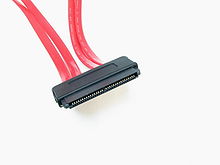
Back واجهة النظام الحاسوبي الصغير الملحقة المتسلسلة Arabic Serial Attached SCSI Catalan Serial Attached SCSI Czech Serial Attached SCSI German Serial Attached SCSI Spanish Serial Attached SCSI Estonian SAS (tietotekniikka) Finnish Serial Attached SCSI French Serial Attached SCSI ID Serial Attached SCSI Italian
This article needs additional citations for verification. (November 2012) |
| Serial Attached SCSI | |
 SAS connector | |
| Width in bits | 1 |
|---|---|
| No. of devices | 65,535 |
| Speed | |
| Style | Serial |
| Hotplugging interface | Yes |
In computing, Serial Attached SCSI (SAS) is a point-to-point serial protocol that moves data to and from computer-storage devices such as hard disk drives, solid-state drives and tape drives. SAS replaces the older Parallel SCSI (Parallel Small Computer System Interface, usually pronounced "scuzzy" [3][4]) bus technology that first appeared in the mid-1980s. SAS, like its predecessor, uses the standard SCSI command set. SAS offers optional compatibility with Serial ATA (SATA), versions 2 and later. This allows the connection of SATA drives to most SAS backplanes or controllers. The reverse, connecting SAS drives to SATA backplanes, is not possible.[5]
The T10 technical committee of the International Committee for Information Technology Standards (INCITS) develops and maintains the SAS protocol; the SCSI Trade Association (SCSITA) promotes the technology.
- ^ "Differences between SAS and SATA".
- ^ "24G SAS Data Storage Specification Development Complete; SCSI Trade Association Spotlights Technology at 2017 Flash Memory Summit". SCSI Trade Association. 2017-08-07.
- ^ Thompson, Robert Bruce; Thompson, Barbara Fritchman (24 July 2003). PC Hardware in a Nutshell: A Desktop Quick Reference. "O'Reilly Media, Inc.". p. 422. ISBN 978-0-596-55234-3.
- ^ NCR Corporation (1990). Scsi: understanding the small computer system interface. University of Virginia: Prentice Hall. p. 5. ISBN 9780137968558.
- ^ "SAS and SATA: Unparalleled Compatibility". Retrieved 2024-05-20.